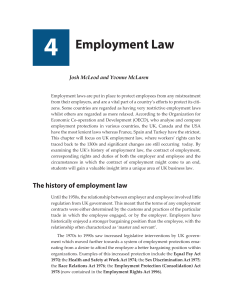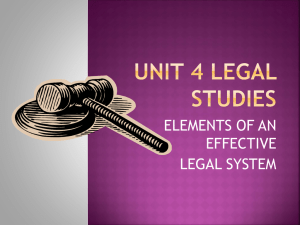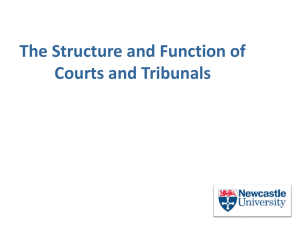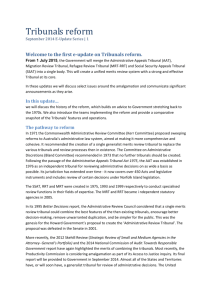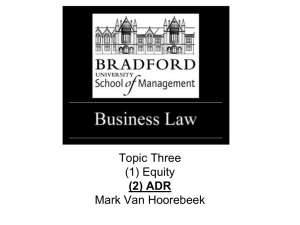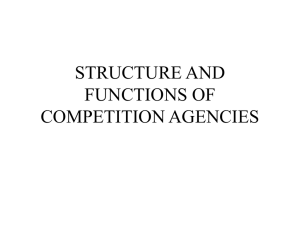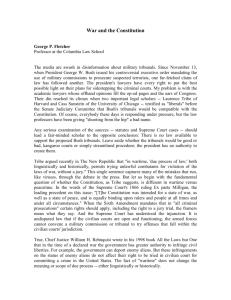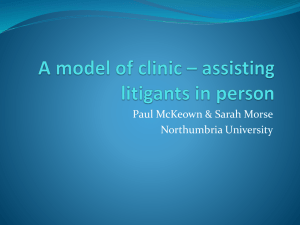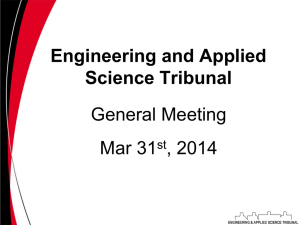The Parliamentary Ombudsman
advertisement
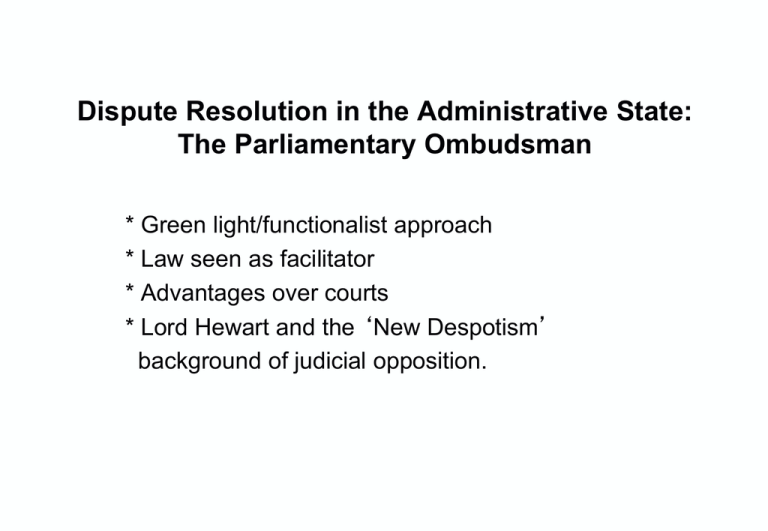
Dispute Resolution in the Administrative State: The Parliamentary Ombudsman * Green light/functionalist approach * Law seen as facilitator * Advantages over courts * Lord Hewart and the ‘New Despotism’ background of judicial opposition. Introduction • Administrative remedies and the grievance chain • Red and Green light vieiws of administrative justice • Recent trends towards cutting legal aid and stressing the importance of ADR. • Parliamentary Ombudsman: plugging the gaps in the grievance chain. • Current role of administrative tribunals. Dispute resolution in a multi-layered constitution • Constitutional system of increasing complexity has emerged over the last 50 years or so. • Supra-national level with the EU and HRA introducing a framework of law super-imposed from above. • Devolution has created a new institutional framework peculiar to Scotland, Wales and Northern Ireland. • Courts increasingly become remedies of last resort • Tribunals and ombudsmen to deal with the administrative state • Citizen remedies: bottom up including mediation and citizen charters. • Leading scholars (Harlow and Rawlings) have analysed administrative law in terms of two conflicting trends: • Red light view - originating from Dicey’s notion of the rule of law which emphasizes a control function, often exercised by the courts. • Green light or functionalist view - which places great emphasis on using the positive values of law as a facilitator. The advocates of this second approach were concerned to design institutions capable of delivering reformist social policies. Trends in administrative justice • ADR and the bottom up perspective on administrative justice • Robson’s objective to develop user friendly mechanisms for the resolution of small claims • Campaign by Laski for legal aid • Preference for tribunals over conciliation because of the importance of finding out the facts (e.g. Street). • Emphasis on consistency in decision-making • Recent trend towards proportionate dispute resolution PDR. The process for putting things right must be proportionate – no disproportionate barriers to users in terms of cost, speed or complexity. Defining ADR • Alternative dispute resolution suggests the handling of disputes outside of the formality of the courts systems. • Further, it suggests the absence of the classic adversarial style which typifies court procedures. • However, having stated these characteristics ADR might refer to a range of different procedures including tribunals, ombudsman, arbitration, mediation, citizen’s charter. Some are much more formal and judicial than others. • In introducing his civil justice reforms Lord Woolf was keen to proceed on the basis that access to justice would be served if the courts were regarded as a forum of last resort for legal disputes. Civil Procedure Rules These rules require the court as part of its duty to actively manage cases to encourage the parties to use ADR if the court consider it appropriate and they are placed under a duty to facilitate the procedure. It also gives the court the power to stay proceedings at the request of the parties or on its own initiative which the parties attempt to settle the case using ADR. Cowl v Plymouth City Council [2001] EWCA 1935 Lord Woof CJ ‘The importance of this appeal is that it illustrates that, even in disputes between public authorities and the members of the public for whom they are responsible, insufficient attention is paid to the paramount importance of avoiding litigation whenever this is possible. Particularly in the case of these disputes both sides must by now be acutely conscious of the contribution alternative dispute resolution can make to resolving disputes in a manner which both meets the needs of the parties and the public and saves time, expense and stress.’ Types of ADR Mediation is where an independent third party helps the parties to reach a voluntary resolution of a dispute. Adjudication involves allows an independent third party to hear claims from two sides with the outcome determined by the adjudicator. Arbitration under the Arbitration Act 1996 is a similar process with the claim heard from outside but the decision of the arbitrator is final and legally binding. Conciliation as a process available in some context, for example the role of ACAS in resolving industrial disputes. ADR involves a number of different processes, some of which may be under a statutory framework e.g. under part VII of the Housing Act 1996 and Social Security Act 1998. Internal assessment is available before the matter goes before a tribunal. • The Crichel Down affair and other administrative failures exposed a manifest gap in the grievance mechanisms available to the individual or group. • ‘ The Citizen and the Administration: the Redress of Grievances’, Whyatt Report 1961 recommended that a parliamentary commissioner for complaints should be instituted and this eventually resulted in the Parliamentary Commissioner Act 1967. • Terminology: Parliamentary Commissioner for Administration, Parliamentary Ombudsman, PCA or PO. (1) The Question of Access ‘MP Filter’ (Limitations) – usurping the role of MPs and preventing the PO from being swamped. Unnecessary. Not a characeristic of other UK ombudsmen. This has resulted in a smaller caseload than comparable institutions e.g. France (2000 p.a. as compared to 17,000). PCA 1967 s.5(1) routed through MPs This limitation should be compared with the Commissioners for Local Administration - 1974 Local Government Act as amended by the 1988 Local Government Act. (2) Limitations in Schedules 2 & 3 Parliamentary and Health Service Commissioners Act 1987, sch. 1, extended the remit of the PO from fewer than 50 to more than 100 departments and non-departmental government bodies, although not all non-departmental government bodies, or ‘quangos' as they are frequently called, are covered Schedule 3: excluded from investigation include: foreign affairs and dealings with international organisations and bodies, criminal investigations, prerogative of mercy, appointments, grants of honours, contractual and commercial transactions of government (important exclusion). (3) Remit What is maladministration? - no definition in the Act ‘Crossman catalogue’ - “bias, neglect, inattention, delay, incompetence, ineptitude, perversity, turpitude, arbitrariness and so on” or is it just ‘any administrative shortcomings’ (Marre - 1973 Annual Report of the PCA). See also the 1993 Annual Report s.12(3) “... nothing in this Act authorises or requires the Commissioner to question the merits of a decision taken without maladministration” s.5(2) not available if there is right of appeal or judicial remedy (4) Emphasis on procedural rather than substantive maladministration (a) at the outset the PO and other ombudsmen were not expected look into a decision where it is the quality of the rules and regulations which are being called into question. (b) PO should not question ‘the merits of a decision taken without maladministration’ (emphasis added). These are known, respectively, as the ‘bad rule’ and the ‘bad decision’. But these issues may be related. Increasing tendency to investigate systemic failings Case study 1 The Ombudsman found that the Benefits Agency and the Independent Tribunal Service had made serious mistakes which caused a long delay to a woman's appeal against a refusal of attendance allowance. An ex-gratia payment was made by the Independent Tribunal Service and the Benefits Agency agreed to consider further compensatory payments if it were shown that the woman's health had been affected. Case study 2 The Ombudsman found that Customs and Excise had made mistakes when measuring and recording the length of a fishing boat, with the result that the boat needed more safety equipment than the owner had been led to suppose. Customs paid £12,000 to the owner of the boat in recompense. (5) Investagative Procedures used by the PO Problem of fairness can arise in regard to the investigation process. Should those subject to investigation be given a right to reply and be legally represented? In general, ombudsmen are an extension of the political process and they assist in the investigation of maladministration in general. They have no powers to insist on the mandatory enforcement of legal rights but are empowered to make recommendations. Occupational pensions and debt of honour report • • • • A large number of pensioners up to 125,000 claimed they had lost money because of a leaflet the PO found to be misleading which had been produced by the Ministry of WP. This was after a comprehensive review of the evidence from more than 500 individuals. Those yet to retire only stood a 50% chance of receiving a full pension. If PO recommendations followed to restore core pensions would cost up to £3.7 bn in repayments. The department flatly rejected the findings and ignored government’s own rule book. This became a constitutional issue R (On the application of Bradley) v SS for Works and Pensions [2008] it was held that in principle the minister can reject PO’s findings if he has reasons for doing so. Quashing order remained to invalidate the decision rejecting the PO’s decision because rejecting one of the findings had been irrational. Although there were significant concessions as a result of the process the government still refused to accept full liability on behalf of the tax payer. For detailed case study see Harlow & Rawlings p.554ff. Principles of Good Administration 1. Getting it right 2. Being customer focused 3. Being open and accountable 4. Acting fairly and proportionately 5. Putting things right 6. Seeking continuous improvement Putting things right = Acknowledging mistakes and apologising where appropriate. Putting mistakes right quickly and effectively. Providing clear and timely information on how and when to appeal or complain. Operating an effective complaints procedure, which includes offering a fair and appropriate remedy when a complaint is upheld. Firewatcher or firefighter 'The office has an adjudicative and inspectorial role, in which "firefighting" and "fire-watching" are combined.' [Harlow and Rawlings]. The role envisaged by Whyatt was an administrative small claims court substitute decisively oriented towards individual small claims (firefighting) rather than a mechanism for overseeing and rooting out administrative inefficiency (firewatching). Conclusions/ effectiveness 1.Higher profile required but the reports provide blue prints of good and bad practice. 2. Remedial action usually follows an investigation and report even if reluctantly e.g. Barlow Clowes but recent dispute with Ministry of Works and Pensions. 3. Guidance notes issued on good administrative practice. Prevention is better than cure. Recent emphasis on establishing general principles of good administration. 4. How long investigations take? The Rolls Royce method but is this appropriate. Politicians favour quick fire remedies, but systemic failure requires much more thorough attention. 5. Freedom of Information Act 2000 part of a trend towards openness but many limitations under the Act. An important plus is an official in the form of the Information Commissioner to enforce compliance. The publication of reports helps but there is no requirement to take further action. 6. Removal of the filter to provide direct access. This change is still called for and would make a significant difference. TRIBUNALS (1) (2) (3) (4) (5) (6) An overview of the system e.g. variety and throughput Comparing courts and tribunals Appeals and judicial review Tribunals and the HRA 1998 Leggatt Review and reform of system Inquiries - how they differ from tribunals Donoughmore and Franks reports • Tribunals pushed towards exercising a courts substitute function • A third tier in the administration of justice • Influence of adversarial procedures strong but also controversial. Franks sought a balance between administrative and judicial functions • Encouraged convergence between tribunals and inquiries Throughput of Tribunals • • • • • • Asylum and Immigration Tribunal - 173,000 cases p.a. Criminal Injuries Compensation Panel - 3,700 cases p.a. Employment Tribunal Service - 89,000 cases p.a. Employment Appeals Tribunal - 1100 cases pa Mental Health Review - 22,000 cases p.a. Social Security and Child Support Appeals - 250,000 cases p.a. Courts and tribunals compared • Inquisitorial rather than adversarial approach • Specialised jurisdictions • A need to encourage applicants: • accessibility, speed, informality and economy • More flexible approach to problem solving Appeals and Judicial Review • Tribunals have been part of a hierarchical appellate structure • Post Leggatt - uniform appeals to an appellate tier/body staffed by by tribunal judges, circuit judges and sometimes High Court judges. • Supervisory role - Court of Appeal • Judicial review on points of law • Ouster clauses to limit the involvement of the courts e.g. Asylum and Immigration Act 2004 Tribunals and the HRA 1998 • Section 6 of the HRA statutory tribunals are regarded as public authorities and as such required to act in a way which is compatible with the European Convention on Human Rights. • Article 6(1) has obvious procedural implications • Section 3 requires tribunals to interpret primary and secondary legislation in a way which is convention compatible but a tribunal cannot issue a declaration of incompatibility. Procedural implications of the HRA • • • • Right of access to an impartial hearing in reasonable time; Public pronouncement of reasoned judgment; Right of parties to be personally present; Compliance with principle of equality of arms e.g. right to see opponents case; • Rules of evidence must be fair. Leggatt Report • Clear separation between minister and authorities whose decisions tested by tribunal • Restructuring of tribunal network • New training scheme - competence based approach • Single route of appeal • Promoting best practice with charter for users and enhanced standards of service Leggatt continued • • • • Civil justice reforms and case management approach Procedures should be speedy, proportionate and cheap No general recommendation for legal aid to be available Council of tribunals to be retained but revamped as Administrative Justice and Tribunals Council and this body would oversee the new system Tribunal Service under DCA • • • • • • • • • • • Finance and Tax tribunals General commissioners of Income Tx Asylum and Immigration tribunal Immigration Service Tribunal Lands Tribunal Pensions Appeal Tribunal Social Security and Child Support Commissioners Transport Tribunal Pathogens Access Appeals Commission Proscribed Organisations Appeals Commission Special Immigration Appeals Commission (SIAC) Six Additional Tribunals under Tribunal Service • • • • • • Employment tribunal service Employment appeal tribunal Special Educational Needs and Disability Tribunal Appeals Service Mental Health Review Tribunal Criminal Injuries Compensation Appeals Panel Not in new service • • • • • • • • Agricultural land tribunal Asylum support adjudicators Care Standards tribunal Family health services appeals authority National Parking adjudication service Parking and traffic appeals service Residential property tribunal service Valuation tribunal service Latest trends in tribunals • Single system compare to Conseil D’Etat. • Emphasis on good administration as with the Parliamentary Ombudsman. • HRA sets procedural norms. • Establishing lines of communication between tribunals and the relevant department, link severed to achieve independence. • Proportionate dispute resolution (PDR) tailored solutions rather than expectation of oral hearing Tribunals and Inquiries compared • Tribunals mainly adjudicative - court substitutes hear appeals against decisions; • Also finding facts and applying legal rules derived from statutes and regulations. • Inquiries are usually fact finding and not necessarily statutory • Inquiries can be part of the original decision-making process or set up after an objections has been lodged against the initial government decision. For many types of inquiry (e.g., land and planning matters) an inspector also hears evidence and finds facts Citizen’s charter and dealing with complaints • ‘The charter adopted a ‘stakeholder’ approach to complaining and suggested a new function for complaints: the so called ‘gift’ function of informing managers of defects in the service.’ (Harlow and Rawlings) • All public services must be seen to be delivering their services on the basis of fair and equitable treatment of all their users. The same principle applies to the handling of complaints (Putting things right). • The Charter has changed the culture and had a lasting impact. Citizens Charter • Wide application throughout public sector • linked to ‘New Public Management’ setting standards and targets • Also linked to contracting between public and private bodies • Publication of target/greater transparency • Citizen treated as customer • Joined up government • Is this really a remedy at all? • Re-badged charters as Service First/Chartermark Conclusion • New unified tribunal service is highly significant • More independent than previously • Note in particular the procedure for appointment of tribunal judges • Wider range of procedures • Human rights consideration require oral hearing plus strong safeguards • Case management approach gives rise to stronger impetus to settle. The Grievance chain • Idea that remedies are available at different levels • Strictly informal e.g. citizen’s advice bureau, law centres, and citizen’s charter. • More formal but not strictly legal e.g. ombudsman with investigatory powers but can only recommend remedies • Tribunals as administrative remedies – large case load, diverts issues from courts and can give legal remedies e.g. compensation, unfair dismissal. • Courts e.g. judicial review : formal remedy of last resort. Typically empowered to quash decisions of public bodies. Further reading • P Cane (2009) Administrative Tribunals and Adjudication, (Oxford: Hart Publishing) • M Elliott Beatson, Mathews and Elliott’s Administrative Law, (Oxford UP, 2011). • C Harlow and R Rawlings Law and Administration, chapter 10 • Richardson, G. and Genn, H. (2007) ‘Tribunals in Transition: Resolution or Adjudication?’ PL 116. • Thomas, R. (2005) ‘Evaluating tribunal adjudication: administrative justice and asylum appeals’ 25 Legal Studies 462. Question and answer • Define the concept of parliamentary sovereignty. • This core concept of the UK constitution means that Parliament is the supreme law-making body empowered to pass or repeal any law. In consequence, it appears that Parliament cannot bind its successors (entrench laws) as the most recent act will prevail over any earlier act. Also, it means that the courts can interpret legislation but cannot question the validity of statute law. • However, sovereignty has been qualified by EU membership ECA 1972 and HRA 1998 as the doctrine of implied repeal does not apply to these statutes.
